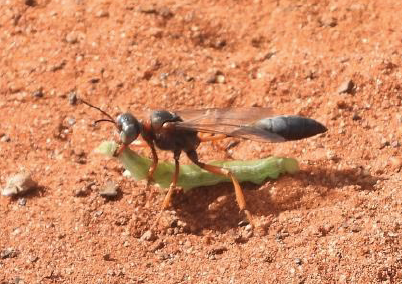Hunting Wasp
Image Credit · Morné Muller
Family: Sphecidae; Genus: Ammophila
As the seasons change on Kameelhoek, so does the activity in the air and on the ground. The long awaited rains arrive, causing an explosion of life as the dried-out soil moistens. Herbivores cry a sigh of relief as dull-coloured veld slowly turns into lush-greenery. Birds and butterflies dance in the wind as to express they’re joy over the blooming landscape. Nature has come alive.
But unbeknownst to those in celebration, the sound of “buzzing” welcomes a different kind of festivity. Swarms of female hunting wasps (Ammophila spp.) gather around pools of accumulated water, and with a sense of urgency congregate around “muddy” surfaces. Driven by a motherly instinct, these hunting wasps use mud and moisture to prepare nests in the form of tunnels in the ground.
Figure 1. Hunting wasp with butterfly ; Belenois aurota larva.
Figure 2. Female wasp removing a soil clod from her nest entrance.
The completion of nests turn the female wasps’ attention toward butterfly larvae (Belenois aurota), who unsuspectingly fall victim to a seemingly merciless attack (Fig. 1). The butterfly larvae (caterpillars) are paralysed by the sting of the wasp, and carried towards the prepared nesting sites.
On arrival, each female wasp searches for her prepared nest, only to uncover the camouflaged entrance by removing a small rock or soil clod (Fig. 2). Hastily, the paralysed, but living victim is dragged into the nest and carefully placed next to a deposited wasp egg. The nest entrance is neatly covered and closed by the mother wasp who without concern, leaves her egg with a tasty meal in preparation for its development.
For the next few weeks, the wasp egg will develop and hatch, releasing a wasp larva who will then feed on the helpless butterfly larva in order to complete its own life-cycle and become an adult hunting wasp.



